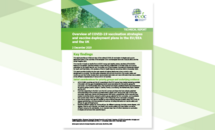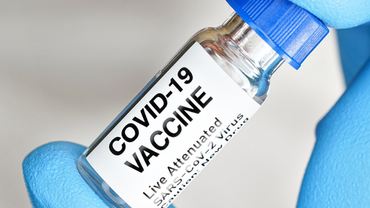Overview of the implementation of COVID-19 vaccination strategies and deployment plans in the EU/EEA
This report provides an updated overview on the progress of national COVID-19 vaccination strategies and deployment in European Union/European Economic Area (EU/EEA) countries, including updates on:
• overall vaccine uptake and uptake by target group; and
• vaccination strategies and policies.
Executive Summary
Vaccine COVID-19 roll-out overview
- As of 19 February 2023 (week 7, 2023), over 976 million COVID-19 vaccine doses had been administered in the EU/EEA, with around 331 million people having received a complete primary vaccination course, 248 million having received a first booster dose, 63.9 million having received a second booster dose, and 5.9 million having received a third booster dose.
- Since the start of COVID-19 vaccine deployment in December 2020, and as of 19 February 2023, the cumulative uptake of the primary vaccination course against COVID-19 in the total EU/EEA population has reached 73% (range: 30.0–86.4%), 54.7% (range: 9.2–75.8%) for the first booster dose, 14.1% (range: 0.2–33.6%) for the second booster dose, and 1.7% (range: <0.1–9.5%) for the third booster dose.
- Among adults (aged 18 years and older) the cumulative vaccine uptake reached 82.4% (range: 35.8−96.4%) for the complete primary course, with no sign of further increase for several months, and 65.4% (range: 11.3−87.0%) for the first booster dose, increasing very slowly.
- The progress of vaccination uptake is diverse across EU/EEA countries, with three countries (Bulgaria, Croatia, and Romania) still reporting less than 25% of the cumulative vaccine uptake of the first booster, and nine countries (Czechia, Estonia, Hungary, Latvia, Liechtenstein, Lithuania, Poland, Slovakia, and Slovenia) still reporting less than 50% of vaccine uptake of the first booster in the total population.
- Approximately 63.8 million second booster doses have been administered to adults aged 18 years and older. Of these adults, 77% are people aged 60 years and older. The cumulative uptake of the second booster dose is 17.2% in those aged 18+ years (range: 0.2−41.9%), 35.4% in those aged 60+ years (range: 0.4−86.6%), and 46.5% in those aged 80+ years (range: 0.3−96.7%). The uptake of the second booster dose among those aged 60+ years has significant variations across EU/EEA countries with 12 countries reporting less than 25% (Bulgaria, Croatia, Czechia, Estonia, Hungary, Latvia, Liechtenstein, Lithuania, Poland, Romania, Slovakia, Slovenia).
- Approximately 5.9 million third booster doses have been administered to adults aged 18 years and older. Of these adults, 91% are people aged 60 years and older. The cumulative uptake of the third booster dose is 2.1% in those aged 18+ years (range: <0.1−11.7%), 2.4% in those aged 60+ years (range: <0.1−38.8%) and 4.2% in those aged 80+ years (range: <0.1−58.2%).
Vaccination strategies and policies during roll-out
- Following the authorisation of primary vaccination in infants and young children aged six months to five years in EU/EEA, 13 countries are recommending primary vaccination to those aged six months to five years with risk factors, seven countries are recommending primary vaccination to all infants and children in this age group, and four countries are not recommending vaccination to this age group.
- Following authorisation of a lower dose of Comirnaty and Spikevax vaccines for children aged five to 11 years in EU/EEA, 25 countries are recommending primary vaccination for all children aged five to 11 years, and four countries recommending primary vaccination to those children in this age group with risk factors. Regarding booster doses, 13 EU/EEA countries are recommending booster doses for those children aged five to 11 years with risk factors and four countries are recommending booster dose for all children in this age group.
- All 30 EU/EEA countries recommend primary vaccination for all 12−17-year-olds. Among all EU/EEA countries, 17 recommend booster vaccination to all adolescents in this age group and nine countries recommend it only for those with risk factors.
- In contrast to the previous ECDC COVID-19 vaccine deployment report published in September 2022, where countries’ approach to vaccine doses administered to their population was based on the number of booster doses (i.e. first booster dose, second booster dose), the approach many countries adapted for the autumn/winter 2022 campaign was based on the interval between the doses (i.e. at least three months since last vaccine dose), rather than the number of booster doses received.
- All 30 EU/EEA countries recommended booster vaccination as part of their autumn/winter 2022 campaigns. The age cut-offs for recommendations for booster vaccination (whether it was a second, third, seasonal booster, or repeat vaccination) for the autumn/winter vaccination strategy differs between countries and was between 50 years and above to 80 years and above, with the majority of countries (14) recommending vaccination to those 60 years and above, following by nine countries recommending vaccination to those 65 years and above.
- The majority of countries are recommending booster vaccination for residents in long-term care facilities (LTCFs), healthcare workers or personnel working in LTCFs, and pregnant women. An interval of minimum of three months to maximum of six months since the last vaccination or COVID- 19 infection is recommended.
- Planning of the future vaccination strategies and campaigns for 2023 is based on each country’s epidemiological situation, the effectiveness of previously administered vaccinations, the potential availability of new, updated and more effective vaccines, and the identification of risk groups. One EU/EEA country (Sweden) has published recommendations for their COVID-19 vaccination strategy for 2023, aiming to maximise the benefits of COVID-19 vaccination for those most at risk and older adults who are vulnerable. The majority of countries are still discussing their future COVID-19 vaccination strategies for 2023 and beyond.
The roll-out of national vaccination campaigns is an ongoing process, and this report provides a snapshot of the progress to date.
Download

Monitor the COVID-19 vaccine roll-out
COVID-19 Vaccine Tracker
This interactive dashboard displays data on the number of vaccine doses distributed to each EU/EEA country and the number of individuals receiving their first and second dose of the vaccine.







